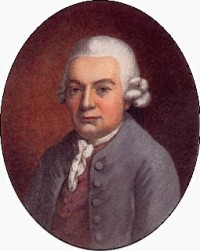by Daniel Hathaway

More like a dynasty perhaps, because the surname “Bach” was nearly synonymous with “musician” in eighteenth-century Thuringia, accounting for more than 50 musicians with the Bach surname before Johann Sebastian’s sons began traveling into the wider world.
And debunking the widespread notion that the music by the most famous of Bachs, C.P.E.’s father Johann Sebastian, was denounced by his sons as old-fashioned and all but forgotten after his death in 1750, a highlight of this year’s institute, which runs from June 15-29, will be the partial reeanactment on June 27 of a famous charity concert C.P.E. gave in Hamburg in 1786. That event featured a performance of the Credo from J.S. Bach’s B-minor Mass, decked out with a new orchestral introduction by the most famous Bach’s most famous son.
The two-week Institute features daily coachings and rehearsals, as well as “Faculty Fringe” events from Mondays through Thursdays covering a wide range of music by Johann Sebastian and his sons and other German musicians of the period. “We like to play a lot of repertory in a short time,” Slowik said. That includes the Biber “Rosary” sonatas for retuned violin as well as J.S. Bach’s “obbligato” sonatas for harpsichord with violin, viola da gamba and flute. The first Friday evening faculty concert on June 20 featured movements from J.S. Bach’s late “speculative” works, the Musical Offering and the Art of Fugue, so called because they weren’t written with a specific performance in mind.
A third “speculative” work is the B-minor Mass, a Catholic mass Bach had no use for as a Lutheran cantor, but was written over a period of time and gathered into its present form in 1749, perhaps for use in Dresden, perhaps just as a legacy composition for his professional collection.
The Credo or Symbolum Nicenum found its way into C.P.E. Bach’s 1786 concert with a few alterations. “By his time, certain instruments had fallen out of favor,” Slowik said, “and C.P.E. adjusted octaves or replaced oboi d’amore with violins and changed the text underlay. C.P.E. treated his father’s manuscript very well in contrast to his brothers, but he was not above making alterations in his own hand in the score. It’s a continually fascinating manuscript to study.”
The 1786 concert is important, Slowik said, “because it was one of the first documented historical performances. It included C.P.E. Bach’s substantial, 40-minute Magnificat and a piece he was very proud of, Heilig, with began with a very up-to-date alto aria then continued with music for double chorus and double orchestra. The first part of the concert consisted of his father’s Credo and two movements from Handel’s Messiah, “I know that my redeemer liveth” and the “Hallelujah” chorus.”
The faculty concert on June 27 at 8:00 in Warner Concert Hall will replicate the first half of the 1786 event as well as feature symphonies by C.P.E. Bach and his siblings, including a work for flutes and strings by Wilhelm Friedmann Bach that will be played by the BPI student orchestra. Tickets are $10 at the door.
Published on ClevelandClassical.com June 24, 2014.
Click here for a printable copy of this article.



